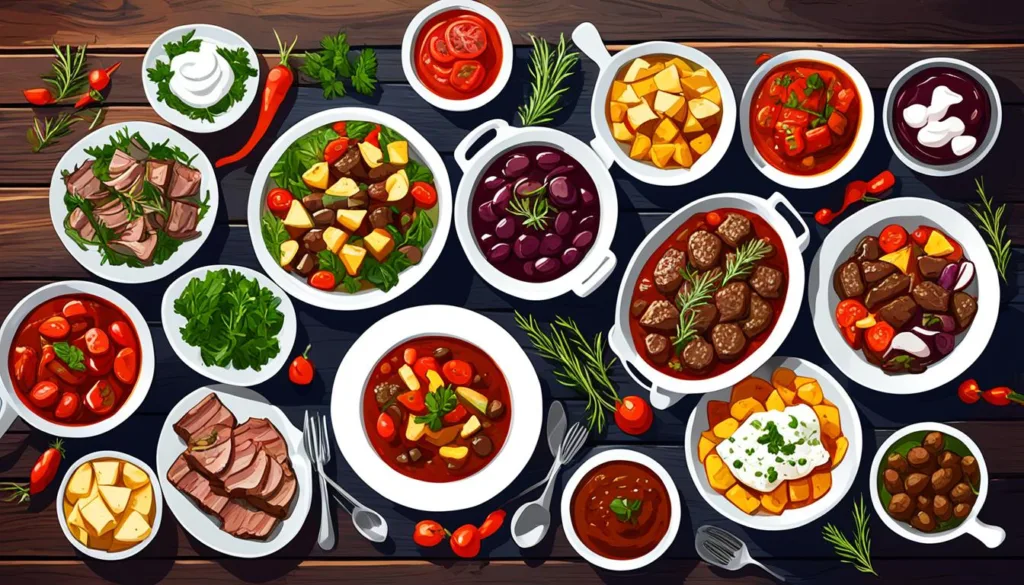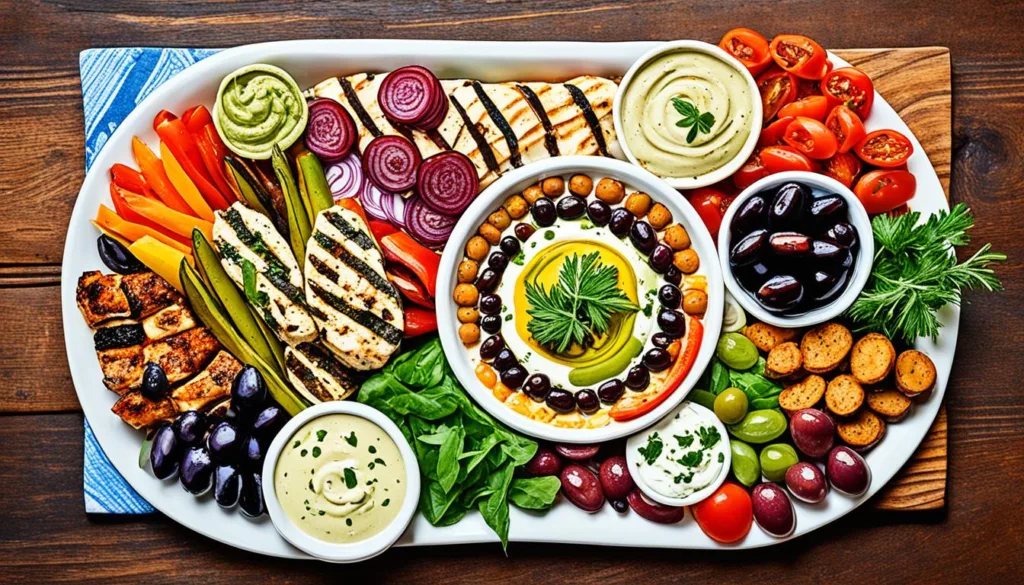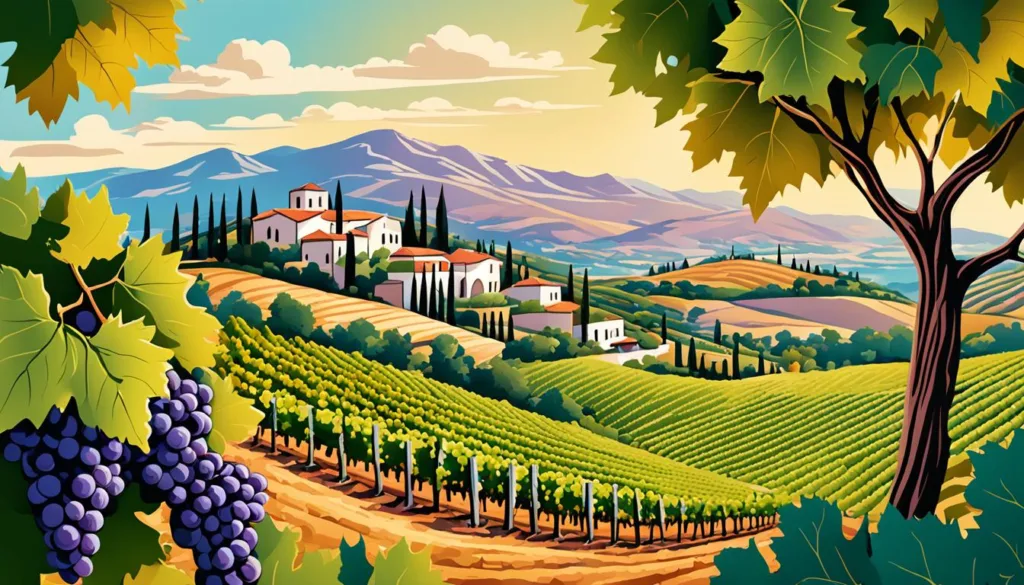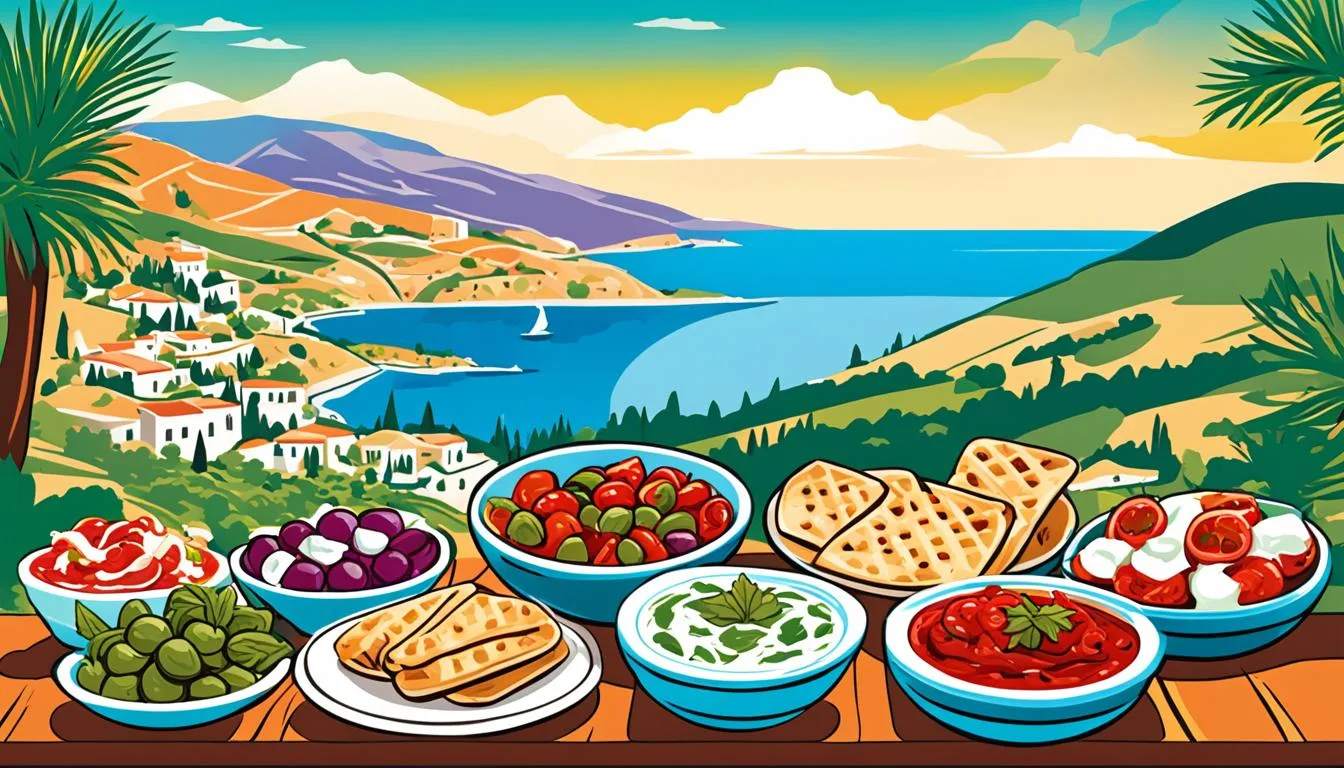With an estimate of more than one million tourists flocking to its serene coasts annually, Cyprus is not just a hub for sun-seekers but also for culinary explorers. The island’s gastronomy is an untold story of its layered history, blending Mediterranean breeze with Middle Eastern zest on a single plate. The Cypriot Dishes Guide offers an immersive dive into traditional Cypriot recipes and the secrets of authentic Cyprus cuisine. Whether it’s tangy olives drenched in locally-produced olive oil or a hearty moussaka that speaks of generations-old Mediterranean cooking tips, Cyprus’s culinary scene is an explosion of tastes waiting to be discovered.
Key Takeaways
- Discover the melting pot of flavors that make up Cyprus’s diverse culinary landscape.
- Explore traditional Cypriot dishes influenced by Greek, Turkish, and British gastronomy.
- Uncover the relaxing dining traditions of Cyprus through local meze and communal meals.
- Gain insider knowledge on Mediterranean cooking tips that bring Cypriot cuisine to life.
- Learn about the staple ingredients and unique dishes that define the authentic Cyprus gastronomy.
- Embrace the cultural experience that Cypriot culinary customs offer to novices and food connoisseurs alike.
The Melting Pot of Mediterranean Flavors: Cyprus’s Culinary Profile
Embark on a savory voyage through Cyprus’s storied past, where a rich tapestry of Cypriot culinary culture is woven from the threads of various civilizations. Discover how the authentic Cyprus cuisine has been shaped and refined over centuries, combining elements from Greek, Turkish, and British food traditions to create a vibrant and distinctive gastronomic identity that is celebrated around the Mediterranean and beyond.
History Shaped by Multicultural Influences
The harmonious blend of cultures in Cyprus is not only reflected in its diverse population but also in its cuisine. A history of cross-cultural mingling and trade has left an indelible mark on the island’s food scene, making it a veritable melting pot where you’ll find traditional dishes sprinkled with spices brought by merchants from distant lands, all contributing to the wealth of Mediterranean cooking tips that guide today’s Cypriot chefs.
Staple Ingredients: From Olives to Seafood
At the heart of Cypriot gastronomy specialties lie the island’s bountiful natural resources. Olive groves and citrus orchards provide a healthy backbone to the cuisine, while coastal waters offer up a fresh catch daily, earning a place of pride on dinner plates across Cyprus. The following table showcases the staple ingredients central to the culinary delights of this Mediterranean paradise.
| Ingredient Category | Examples | Role in Cuisine |
|---|---|---|
| Vegetables | Tomatoes, Cucumbers, Zucchini | Base for salads and stews |
| Oils and Fats | Olive Oil, Halloumi | Cooking medium, flavor enhancer |
| Legumes | Lentils, Chickpeas, Beans | Protein source in soups and salads |
| Spices & Herbs | Cinnamon, Coriander, Mint | Aromatic elements in dishes |
| Seafood | Fish, Octopus, Calamari | Main courses, enjoyed grilled or fried |
Through the lens of these ingredients, one gains insight into the essence of Cyprus’ culinary offerings. An understanding of the regional flavors and cooking techniques can elevate your appreciation for authentic Cyprus cuisine and inspire you to incorporate these Mediterranean cooking tips into your own kitchen.
Signature Cypriot Dishes Every Foodie Must Try
For gastronomy enthusiasts looking to immerse themselves in the cultural delights of Cyprus, diving into the island’s traditional Cypriot recipes is essential. Cyprus offers an array of popular Cypriot foods that are not just meals, but an embodiment of the island’s rich history and culinary expertise. Each dish brims with flavor and tells a story of the land where it originated.

The cornerstone of Cypriot cuisine is undoubtedly its tantalizing meat dishes. One must not leave the island without savoring Kleftiko, a traditional, slow-roasted lamb or goat masterpiece, seasoned with bay leaves and marinated in garlic and lemon. This succulent dish is emblematic of the care and patience embedded in Cypriot cooking methods.
Another staple that captures the essence of Cypriot grilled meat traditions is Souvlaki, comprised of small, marinated pieces of meat grilled on a skewer. It’s often enjoyed with fresh pita bread, crisp vegetables, and a dollop of tzatziki sauce. Meanwhile, Sheftalia, succulent grilled sausages wrapped in caul fat, are a rich complement to any Cypriot feast and demonstrate the local affection for robust flavors.
Vegetarians and cheese lovers alike will revel in the versatility of Halloumi. This semi-hard cheese, with its high melting point, grills to perfection, providing a savory experience that’s unparalleled. Often served with a light drizzle of olive oil and a sprinkle of dried mint, it’s a common find among the best Cypriot restaurant dishes.
Below is a table highlighting these must-try dishes, their main ingredients, and why they are considered the pinnacle of Cypriot gastronomy:
| Dish | Main Ingredients | What Makes It Special |
|---|---|---|
| Kleftiko | Lamb or goat, garlic, lemon, bay leaves | The slow-roasting process that locks in an infusion of aromatic herbs and tenderizes the meat. |
| Souvlaki | Grilled meat skewers, pita bread, tzatziki sauce | Fresh, marinated meat with a repertoire of traditional seasoning served in a handheld format. |
| Sheftalia | Minced meat, parsley, onion, caul fat | A distinctively Cypriot sausage that’s grilled to juicy perfection, offering a burst of herbed meaty flavors. |
| Halloumi | Cheese, mint | This versatile cheese can be grilled or fried without losing its shape, creating a unique culinary component. |
To explore the vibrant tableau of popular Cypriot foods is to experience a part of the island’s soul, one that resonates through each beguiling bite and satisfied palate. A journey of taste that no food lover should miss.
A Taste of Tradition: Exploring Cypriot Meze Culture
The traditions of Cyprus extend far beyond its sun-kissed shores and into the heart of every family gathering and festive celebration through its revered meze culture. Cypriot meze culture is not just about the food; it is an expression of hospitality and community, a symphony of flavors that invites diners to engage with each other over a variety of small, yet flavor-packed dishes. Let’s delve into the essence of this beloved dining practice that is synonymous with traditional Cypriot recipes and authentic Cyprus cuisine.
The Essence of Sharing: Savoring the Meze Experience
Meze is not merely a collection of dishes but a dining ritual central to Cypriot life. It’s a sociable experience where friends and family convene, conversations flow, and dishes are enjoyed at a leisurely pace. This joyous occasion reflects the essence of Cypriot culture—unity, generosity, and a deep-rooted love for life and food. The ritual lays the foundation for an authentic Cypriot cuisine experience, enabling participants to enjoy a taste of tradition in every bite.
Popular Meze Dishes: A Sampler of Cypriot Variety
A Cypriot meze is a colorful palette of the island’s gastronomic diversity. The variety is astonishing, ranging from delicate dips to robust meat dishes and everything in between. To truly appreciate the vibrancy of Cypriot meze culture, one must familiarize themselves with the staples that epitomize the aromatic and textural richness of this culinary tradition.
| Meze Category | Description | Examples |
|---|---|---|
| Dips & Spreads | Foundational to any meze, used for dipping bread or as accompaniments. | Tzatziki, Taramosalata, Hummus |
| Vegetables | Often marinated or cooked with traditional herbs and spices. | Grilled Halloumi, Cypriot Salad, Lountza |
| Seafood | A coastal favorite, featuring the island’s plentiful and fresh catch. | Grilled Octopus, Calamari, Cuttlefish |
| Meats | Char-grilled or cooked to tender perfection using various Cypriot marinades. | Souvlaki, Sheftalia, Kleftiko |
| Legumes & Pulses | A rich source of protein, prepared in hearty stews or refreshing salads. | Chickpea Soup (Revithia), Fasolada |
| Breads & Pita | Freshly baked daily, an essential part of the meze for scooping dips. | Cypriot Pita Bread, Olive Bread |
| Desserts & Sweets | The sweet conclusion to the meze, often featuring nuts, honey, or fruit. | Baklava, Glyko tou koutaliou |

An authentic meze in Cyprus might feature dozens of these dishes, laid out in succession, to ensure guests can savor each flavor and delight in the vast array of traditional Cypriot recipes presented to them. Ultimately, meze is a culinary journey that embodies the generous and convivial spirit of Cypriot meze culture, and it offers a window into the soul of authentic Cyprus cuisine.
Cypriot Dishes Guide: Savory Classics to Sweet Delights
Embark on a gastronomic tour through our Cypriot Dishes Guide, savoring the harmonious blend of flavors from popular Cypriot foods. It’s a cultural canvas that plays out through its celebrated traditional Cypriot recipes, where savory meets sweet to create a full-bodied culinary experience.
Dive into the hearty essence of Cypriot cuisine with the ever-popular Moussaka, a layered masterpiece of eggplants, minced meat, and creamy béchamel. From this savory delight, transition to the sweet culmination of the island’s cuisine with Baklava and Galaktoboureko. These desserts are not just confections but embody the festive spirit of Cyprus.
- Moussaka: A lusciously baked concoction often enjoyed at family gatherings.
- Sheftalia: Succulent sausage parcels that are a go-to treat for meat lovers.
- Stifado: A robust beef stew that flawlessly showcases traditional spices and seasonings.

A meal in Cyprus is a celebration of its history, a tale told through its rich flavors and time-honored traditions, something every food enthusiast must experience.
| Dish | Description | Meal Time |
|---|---|---|
| Moussaka | An iconic baked dish, layering eggplants with minced meat and topped with a rich béchamel sauce. | Dinner |
| Baklava | Delicate pastry made of phyllo dough, filled with nuts and honey, a sweet tradition served across the island. | Dessert |
| Galaktoboureko | Custard filled phyllo pastry that hits all the right notes of sweetness and texture, perfect after a savory meal. | Dessert |
Whether you’re longing for the comfort of a hearty entrée or the sweet kiss of a dessert, the Cypriot kitchen offers a dish to capture every palate. It’s little wonder that Cypriot cuisine takes such a prominent place on the Mediterranean culinary stage.
From Vine to Wine: The Art of Cypriot Winemaking
Delve into the world of Cypriot winemaking art, a practice steeped in the history and rich soils of the island that gives life to exceptional wines. This revered tradition harnesses the potential of indigenous grape varieties, crafting beverages deeply embedded in the cultural fabric of Cyprus.
Indigenous Grapes – A Headstart in Viticulture
Key to its winemaking success, Cyprus is home to unique grape varieties that are not found elsewhere. The Xynisteri, a white grape bestowing a refreshing acidity to wines, and Maratheftiko, a red grape known for its robust flavor and body, are cornerstones of this age-old craft. These grapes flourish under the Cypriot sun, giving rise to vibrant and characterful wines, and etching the island’s name on the vinicultural world map.
Commandaria: The Legendary Cypriot Wine
Among the pantheon of Cypriot wines stands a legendary name: Commandaria. This luscious sweet wine, with an illustrious past spanning centuries, is a testament to the enduring legacy of Cyprus’s winemaking excellence. Made from sun-dried grapes and aged in oak barrels, Commandaria’s rich amber hue and complex flavors enrapture those who taste it, affirming its stature as a treasured national icon.
Below is a comparative glimpse into the characteristics of the two indigenous grape varieties that have helped shape the distinctive profile of Cypriot winemaking:
| Grape Variety | Color | Flavor Profile | Wine Type | Notable Wines |
|---|---|---|---|---|
| Xynisteri | White | Fresh, citrusy, with a hint of green apple | Dry to medium wines | Cypriot Whites, Blends |
| Maratheftiko | Red | Rich, cherry, with herbaceous undertones | Robust reds | Single varietals, Rosé |
Elevating the Cypriot winemaking art to its present acclaim, the meticulous cultivation of these native grape varieties and the traditional methods refined over millennia, converge in a bottle of Commandaria. Enshrined in legal protections, it is a wine that encapsulates the spirit of Cyprus, beloved by sommeliers and novices alike. It stands proudly as the pinnacle of the island’s winemaking achievements.

Local Libations: Beverages that Capture the Cypriot Spirit
While Cyprus may be celebrated for its luscious wines, the island’s robust Cypriot beverages culture offers a diverse drinking experience. Among these, the Zivania spirit stands as a potent emblem of Cypriot zest. This clear, strong distillation, often consumed as a digestif, is a testament to the island’s tradition of toasting to good health and spirited gatherings.
Fusing the warmth of tradition with the vibrancy of modern life, Cypriot coffee culture is a social affair not to be rushed. The coffee, meticulously brewed in a traditional briki, is more than a caffeinated concoction—it’s a daily ritual that encapsulates the leisurely spirit and convivial atmosphere of Cyprus.
In Cyprus, our coffee lingers as long,
and is as strong, as our conversations.
Beyond the rich flavor and unique preparation, Cypriot coffee culture encompasses intricate customs, from the distinct manner of serving to the art of reading the cup’s residue as a form of fortune-telling, further enriching this daily practice that anchors the social fabric of the Cypriot people.
- Traditional Cypriot coffee preparation
- The significance of Zivania in Cypriot celebrations
- How beverages serve as a catalyst for community and conversation
| Beverage | Description | Occasions |
|---|---|---|
| Zivania | A traditional Cypriot grape-based spirit, characterized by its high alcohol content and pure taste. | Festivals, family gatherings, and as an after-dinner digestif. |
| Cypriot Coffee | Strongly brewed and often enjoyed over a prolonged conversation, served with a glass of water. | Daily socialization, coffee shops, and after meals. |
Whether it’s the fiery warmth of Zivania or the thick, aromatic trails of a freshly brewed Cypriot coffee, each sip offers an authentic connection to the island’s vibrant culture and spirited lifestyle.
The Halloumi Haven: Discovering Cypriot Cheese Specialties
Embark on a delectable journey through the heart of Cyprus’s cheese culture, where the esteemed Halloumi reigns supreme. This semi-hard cheese, renowned for its high melting point, exemplifies the ingenuity of Cypriot cheese specialties. Infused with a blend of sheep’s and goat’s milk, and sometimes cow’s milk, Halloumi’s layered textures and robust flavors are a testament to the Halloumi versatility found in the island’s gastronomy.
The Versatility of Halloumi in Cypriot Cuisine
Known for its distinctive, squeaky bite, Halloumi has a culinary flexibility that makes it a staple in kitchens across Cyprus. This cheese’s unique ability to retain its structure when grilled or fried allows chefs and home cooks alike to innovate with confidence. A golden-brown crust reveals an irresistibly tender interior, ready to elevate any dish among the best Cypriot restaurant dishes.
Pairing Suggestions and Culinary Applications
Halloumi’s adaptability is showcased in various dishes, adding a satisfying chewiness to salads, sandwiches, and traditional meze platters. Here are some exemplary ways to savor this Cypriot treasure:
- Grilled Halloumi: Enjoy it with a drizzle of honey and a sprinkle of crushed walnuts for a tantalizing blend of salty-sweet flavors.
- Halloumi Salad: Combine with arugula, pomegranate, and a citrus dressing for a refreshing, vibrant meal.
- Halloumi Fries: Experiment with this twist on a classic snack, serving with a side of spiced yogurt dip.
- Stuffed Peppers: Fill bell peppers with a mixture of Halloumi, quinoa, and fresh herbs, then bake to perfection.
Embracing Halloumi within your culinary repertoire is not only a nod to Cypriot tradition but also a step towards widening the scope of your cheese-based dishes, underscoring the cultural and gastronomic significance of this beloved Cypriot gem.
Cyprus’s Best Kept Secrets: Popular Cypriot Foods Off the Beaten Path
When wandering off Cyprus’s main culinary avenues, one may stumble upon a world of popular Cypriot foods yet to gain international fame. These hidden treasures within the Cypriot culinary culture offer a taste of the authentically rustic, the home-cooked, and the traditionally opulent. This is where the island’s spirit is baked into every bite, where every sip of a locally crafted beer feels like a warm Cypriot welcome.
Among these unsung heroes of the Cypriot menu are dishes like Koupes—a shell of bulgur wheat filled with minced meat and spices, echoing the island’s agrarian soul. Nearby, in the humming corridors of local markets, one can encounter an array of traditional Cypriot recipes, from uniquely prepared olives to the heartwarming aroma of freshly baked bread.
- Koupes: A crispy envelope with a heart of seasoned meat, echoing the whispers of ancient spice trades.
- Loukoumades: Honey-soaked doughnuts sprinkled lightly with cinnamon, a sweet testament to Cyprus’s love for confectionery.
- Molhiya: A wholesome, hearty stew with roots deeply entwined in Middle Eastern cuisines.
- Chiromeri: A sun-dried, wine-marinated pork that defines the essence of Cypriot preservation techniques.
The richness of Cypriot culinary culture doesn’t end at the table. Stroll further down the cobblestone streets to discover the liquid craftsmanship that is Cypriot brewing. Artisanal microbreweries dot the landscape, offering expertly crafted beers that perfectly encapsulate the zest of the island’s youthful and innovative gastronomic scene.
While Cyprus continues to charm the world with its signature dishes, the island’s culinary backroads, with their hum of tradition and innovation, hold a gastronomic allure all their own. So, dive in, taste, and let the warmth of the Cypriot hearth encapsulate your senses.
Cypriot Culinary Culture: Festivals and Gastronomic Events
The vibrant spirit of Cypriot culinary culture thrives not just in the kitchens and restaurants, but in the exuberant festivals and events dedicated to the island’s gastronomy. These gatherings are vital social fixtures on the Cypriot calendar, bringing communities together to celebrate, indulge, and showcase the rich flavors that are the hallmark of their cuisine. Let’s dive into some of the most anticipated events that put Cypriot gastronomy on display.
Limassol Wine Festival: A Grape-Lover’s Paradise
Each year, the city of Limassol becomes the focal point for oenophiles with its renowned Limassol Wine Festival. This event brings to light the exquisite wine-making traditions of Cyprus, providing an opportunity for visitors to taste the essence of local vineyards through a variety of high-quality wines. With a festive atmosphere, punctuated by folk music, dance, and theatrical performances, the Limassol Wine Festival is a tribute to the ancient God of wine, Dionysus, and a true celebration of life.
As the sun sets, the festival grounds come alive with revelers gathered around wine stalls, each one eager to savor the robust flavors and to learn stories behind the island’s most cherished libations. Here, wine is more than just a drink—it’s a cultural touchstone passed through generations, an art form that encapsulates the soul of the island.
Year-Round Gastronomic Celebrations in Cyprus
Cyprus’s festive calendar is dotted with a variety of Cypriot gastronomy festivals that honor different aspects of the island’s food heritage. Festivals such as the Anogyra Pasteli Festival celebrate the traditional Cypriot sweet made of carobs and nuts. The Ayia Napa Street Food Festival, on the other hand, is a paradise for those wanting to explore modern takes and international adaptations on beloved traditional dishes.
These occasions are more than just an opportunity to eat; they are immersive experiences that tell the story of Cypriot culture through every bite. They foster a sense of community and stand as testaments to the island’s enduring love affair with good food, good wine, and the good company in which to enjoy it all.
Embracing the full range of the island’s culinary delights, these festivals are a testament to the diverse influences and flavors that shape Cypriot culinary culture. For a food lover, they offer a plentiful and jubilant tableau of the best that Cypriot cuisine has to offer. It’s a cultural exploration as much as a culinary one, and it’s an open invitation to all who wish to partake in these yearly celebrations.
Conclusion
The influence of Cypriot cuisine on the culinary tapestry of the world is a testament to the island’s rich cultural confluence and the universal language of delicious food. On this flavorful journey, we’ve dipped into the essentials of Cyprus’s gastronomic practices, unearthing the roots and inevitable global spread of some of its most iconic dishes. From the hearty meat feasts and cheese masterpieces to the sophisticated art of local winemaking, the kitchen secrets of this Mediterranean gem are now globally recognized, strengthening Cyprus’s presence on the world stage of gastronomy.
The Lasting Legacy of Cypriot Cuisine on Global Gastronomy
As we’ve come to learn, the sun-kissed island not only offers a haven for food aficionados but also extends its influence far beyond its shores. Halloumi and Commandaria are not mere export commodities; they embody Cyprus’s generous spirit and culinary prowess, contributing significantly to the global gastronomy influences. Such elements of the Cypriot dishes guide have encouraged chefs and food enthusiasts worldwide to weave classic Mediterranean flavors into their culinary repertoires, hallmarking the universal appeal of Cypriot cuisine.
Embarking on Your Own Cypriot Culinary Adventure
It is one thing to read about these gastronomic treasures; it is another to taste and experience them firsthand. Whether you’re venturing to Cypriot shores to indulge in an authentic Cypriot culinary adventure or bringing the island’s flavors into your own kitchen, the exploration is a rewarding endeavor. Creating dishes steeped in tradition, with a touch of personal flair, you too can champion the diversity and excitement of Mediterranean cooking. Cyprus invites you to celebrate its dedication to culinary excellence, urging you to craft your own stories and memories flavored with the richness of its age-old recipes and cooking wisdom.






